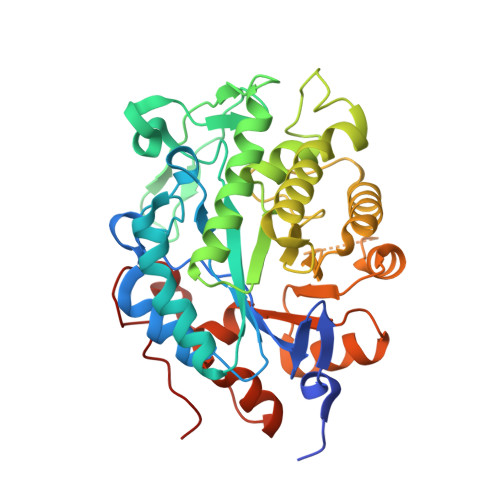X-ray structure of 12-oxophytodienoate reductase 1 provides structural insight into substrate binding and specificity within the family of OYE.
Breithaupt, C., Strassner, J., Breitinger, U., Huber, R., Macheroux, P., Schaller, A., Clausen, T.(2001) Structure 9: 419-429
- PubMed: 11377202
- DOI: https://doi.org/10.1016/s0969-2126(01)00602-5
- Primary Citation of Related Structures:
1ICP, 1ICQ, 1ICS - PubMed Abstract:
12-Oxophytodienoate reductase (OPR) is a flavin mononucleotide (FMN)-dependent oxidoreductase in plants that belongs to the family of Old Yellow Enzyme (OYE). It was initially characterized as an enzyme involved in the biosynthesis of the plant hormone jasmonic acid, where it catalyzes the reduction of the cyclic fatty acid derivative 9S,13S-12-oxophytodienoate (9S,13S-OPDA) to 1S,2S-3-oxo-2(2'[Z]-pentenyl)-cyclopentane-1-octanoate. Several isozymes of OPR are now known that show different stereoselectivities with regard to the four stereoisomers of OPDA. Here, we report the high-resolution crystal structure of OPR1 from Lycopersicon esculentum and its complex structures with the substrate 9R,13R-OPDA and with polyethylene glycol 400. OPR1 crystallizes as a monomer and folds into a (betaalpha)(8) barrel with an overall structure similar to OYE. The cyclopentenone ring of 9R,13R-OPDA is stacked above the flavin and activated by two hydrogen bonds to His187 and His190. The olefinic bond is properly positioned for hydride transfer from the FMN N(5) and proton transfer from Tyr192 to Cbeta and Calpha, respectively. Comparison of the OPR1 and OYE structures reveals striking differences in the loops responsible for binding 9R,13R-OPDA in OPR1. Despite extensive biochemical characterization, the physiological function of OYE still remains unknown. The similar catalytic cavity structures and the substrate binding mode in OPR1 strongly support the assumption that alpha,beta-unsaturated carbonyl compounds are physiological substrates of the OYE family. The specific binding of 9R,13R-OPDA by OPR1 explains the experimentally observed stereoselectivity and argues in favor of 9R,13R-OPDA or a structurally related oxylipin as natural substrate of OPR1.
Organizational Affiliation:
Max-Planck-Institut für Biochemie, Abteilung Strukturforschung, Am Klopferspitz 18a, D-82152, Martinsried, Germany. breitha@biochem.mpg.de



















